Active Research Projects
Projects as Principal Investigator
 |
Updating Friction/Texture Demand Categories for Improved Pavement Design GuidanceNorth Carolina Department of Transportation, 2024-2026 Abstract: The skid qualities of pavements play an important role in road safety. This project is evaluating the interaction between pavement surface characteristics and quality and will seek to achieve four objectives: 1) validate the proposed friction/texture performance models and their respective investigatory and intervention thresholds; 2) categorize friction demand for existing pavement sections, 3) develop a decision framework that allows identifying the surface characteristics that satisfy friction demand requirements; and 4) develop a quality assurance protocol to evaluate the pavement surface at the time of construction. The primary outcome of the proposed research will include friction demand categories and recommendations for design strategies on sites requiring high friction/texture performance. Higher crash risks are associated with combinations of friction and macrotexture that result in low skid resistance values. Therefore, by controlling the skid resistance performance on roadways through more informed management or material design practices it could be possible to reduce the number of collisions related to skid resistance problems. |
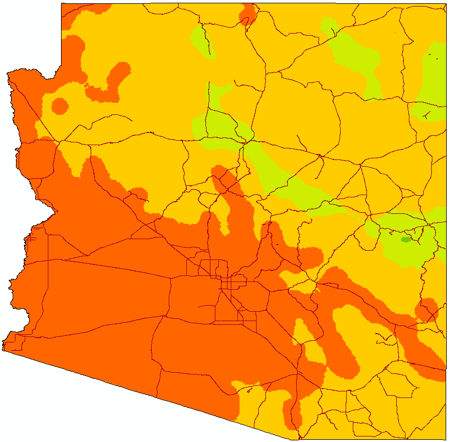 |
Pavement Performance Impacts Predicted by Climate Change Models in Arizona, Phase 2Arizona Department of Transportation, 2023-2025 Abstract: General circulation models (GCM) for the global climate, have predicted wide ranging changes over the next several decades. Some of these changes relate to roadways and pavement infrastructure. As outlined by the Arizona DOT’s Asset Management, Extreme Weather, and Proxy Indicators Pilot Project report, pavement impacts from future extreme events and climate patterns are expected to include decreased lifespan due to extreme heat and extreme cold as well as changes in the specific patterns of each (e.g., freeze/thaw cycling and heat waves). In this project, the NCSU research team is working with GCMs in Arizona to; provide insights and analysis to identify relevant pavement related climate stressors, identify the weather related risks to these pavements, quantify the impacts to specific assets, and assess which assets are at critical risk. This work will also be of value to other agencies outside Arizona by providing tangible examples that they can replicate with respect to analysis and interpretation for each step in this framework. |
 |
Identification and Prioritization of Vulnerable Roadway Segments for Proactive Resilience Planning and ResponseNorth Carolina Department of Transportation, 2023-2025 Abstract: Recent hurricanes and other extreme events have caused more than $450 million in direct damage to North Carolina’s transportation infrastructure and innumerable indirect damage from losses in mobility, additional travel times needed while repairs were made, and other impacts. This study will further the understanding of damages and potential adaptation pathways by: providing a better understanding of the failure pathways and factors contributing to pavement failures during past events; identifying the gaps and critical data linkages that hinder the use of existing NCDOT information to support resilience-based planning with respect to pavements; developing Develop a framework for identifying and prioritizing road segments as part of resilience-based improvement plans/programs; developing a design feature selection and repair strategy decision tree that considers specific features, planned needs, sustainability considerations, and possible extreme event stressors at a given pavement site, and identifying data gaps and critical data linkages that hinder the use of existing NCDOT information to support this effort and provide recommendations to improve data collection and information to support resiliency efforts. The primary outcome of the proposed research will be a design feature selection and repair strategy decision tree that considers specific features, planned needs, sustainability considerations, and possible stressors at a given pavement site. |
 |
Evaluation of Macrotexture and Friction of Alternative Asphalt Surface Course MaterialsNorth Carolina Department of Transportation, 2023-2024 Abstract: Vehicle collisions and increases in collisions rates during wet conditions are one of the major safety concerns for the NCDOT. Collision rates increase when the surface is wet because skid resistance reduces under these conditions. In recent years the NCDOT has conducted different research efforts to characterize the friction and texture characteristics of North Carolina mixes. In this project, the NCSU research team will characterize friction and texture performance of alternative surface mixture designs from other states, and identify alternative structural mixture designs that can be specified to ensure adequate friction and texture performance in North Carolina. The primary outcome of the proposed research will include new or improved asphalt mix design specifications updated to include new mixture categories that could be selected by NCDOT pavement designers in situations that warrant higher surface texture and/or friction. Given the existence of specifications for such mixes in other states, it is likely that the recommendations can have immediate impact. These outcomes can be used by the Traffic Safety and Materials and Test Units of the North Carolina DOT. |
 |
Balanced Asphalt Mix Design for North CarolinaNorth Carolina Department of Transportation, 2022-2024 Abstract: Current procedures for asphalt mixture design in North Carolina requires contractors to conform to volumetric requirements on the air void content, voids in mineral aggregate, and other parameters at a fixed, traffic- and layer-specific compaction effort. The presumption in this case is that the mixtures produced under the same guidelines will have similar properties. However, recently, RP2019-20 has evaluated the mechanical properties of asphalt mixtures from across North Carolina produced under the same mixture design guidelines and found notable differences in the resultant performance. In light of these issues, this research will; (1) identify the most appropriate durability related testing protocol for incorporation into mix design and quality assurance/control operations, (2) establish initial threshold limits for the test identified, (3) develop a draft balanced mix design (BMD) procedure for North Carolina, and (4) develop a draft protocol for integrating the identified performance tests into quality assurance and quality control operations. |
Projects as Co-Principal Investigator
 |
University Transportation Centers of Excellence Sustainable and Resilience InfrastructureNorth Carolina State University, PI: Tim Brock (NCSU, ITRE) Abstract: Developing sustainable and resilient infrastructure systems is vital to ensure that transportation investments deliver reliable, long term mobility options for the citizens of North Carolina. The North Carolina Department of Transportation (NCDOT) has shown a deep commitment to developing sustainable and resilient infrastructure to transportation facilities and systems across the state. To better prepare for and mitigate disruptions in the transportation network, NCDOT is developing a Center of Excellence focusing on sustainable and resilient infrastructure research. The portion of the research being carried out through this multi-institutional research consortium that involves PI Underwood will: identify and document the policy and process landscape related to NCDOT policy on asset management; develop a ranking system to aid the NCDOT in choosing strategies that manage infrastructure assets for resilience considerations; develop a decision support guideline that documents and quantifies the resilience impacts from engineering and operational strategies; identify the policy implications to implementing the guide; and and identify data sources that would aid expansion of the rankings for network prioritization. |
 |
Impact of Flooding on the Resilience of Pavement SystemsNational Cooperative Highway Research Program, PI: Applied Pavement Tech. Abstract: Transportation agencies have dealt with natural events and their consequences for decades. However, recent extreme events have been particularly catastrophic and with climate change, projections suggest that these types of events will be more prevalent and impactful in the future. When these events occur, pavements are flooded and the life of these pavements can be greatly affected. This research will address these issues and meet the following objectives: Develop a guide for state departments of transportation (DOTs), local agencies, and practitioners to help quantify the effect of flooding on pavement systems, and improve pavement system resilience during planning, design, construction, operation, and maintenance in flood-prone areas. Develop a framework for state DOTs to incorporate analyses, material characterization, and other tools to consider the effects of flooding into mechanistic-empirical pavement design. |
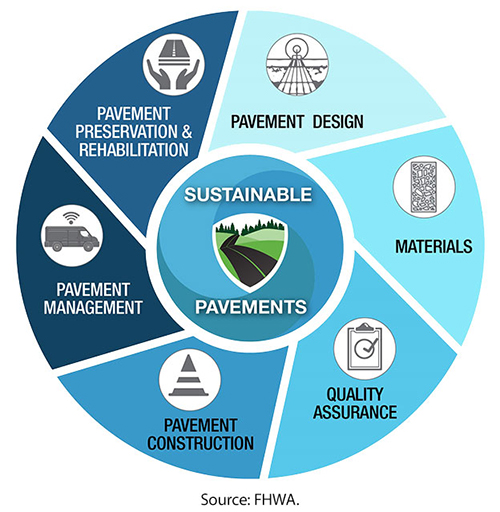 |
Arizona Roadway Wildfire Management Decision SupportArizona Department of Transportation, PI: Mikhail Chester (ASU) Abstract: Annual wildfire frequency, severity, and total area burned have been steadily increasing over the last three decades in the western United States and caused billions of dollars in damage and economic losses To develop cost effective strategies that mitigate these impacts the U.S. Forest Service (USFS) utilizes and advocates for a framework that characterizes wildfire likelihood and intensity, fire effects, and the relative importance (or value) of assets Transportation infrastructure is often some of the highest valued built assets in wildfire regions and is critical to personal mobility, goods movement and in the event of disasters the rescue of people and access to critical services. Water and debris flow in excess of design standards increase the likelihood of functional or structural failure for roadway infrastructure elements including culverts, bridges, and drainage systems. This project will create novel forecasts for future roadway vulnerability to wildfires and post-fire debris flows, assess vulnerability considering both physical assets and the communities they serve, and create a decision-support framework to guide ADOT towards proactively managing roadway risk with future uncertainty. |
 |
Safety of Earthen Stormwater Infiltration Best Management Practices (BMP) Adjacent to Highways – Phase IICalifornia Department of Transportation, PI: Narayanan Neithalath (ASU) Abstract: Stormwater best management practices (BMP) are in place to prevent pollution in stormwater runoff from Caltrans properties and also to facilitate the stormwater discharge from road infrastructure. Caltrans is required to comply with the National Pollution Discharge Elimination (NPDES) permit, including the infiltration of stormwater runoff from the highway, and required to implement soil based BMPs. As per California State Water Resources Control Board order 2012-0011-DWQ, Caltrans needs to install soil based BMPs that are capable of allowing infiltration of the 85th percentile of a 24-hour stormwater event. The area available for this purpose is typically the clear recovery zone (CRZ), including embankments and slopes that must be traversable and recoverable to meet traffic safety requirements. Thus, compliance with the NPDES must also come with adherence to traffic safety design requirements. The overall goal of this project is to highlight possible updates to design guidance, tools, and specifications for Caltrans’ stormwater BMPs to continue to refine the balance between roadside discharge requirements and traffic safety performance targets. This project builds on previous research conducted by NCSU in collaboration with ASU. |
 |
ER23-C3-3683 – PFAS Transport and Interaction with Portland Cement and Asphalt Concrete: A Field and Laboratory StudySERDP, PI: Mohammad Pour-Ghaz (NCSU) Abstract: Portland cement concrete (PCC) and asphalt concrete (AC) exposed to AFFF have become an increasing challenge and environmental liability for the department of defense (DoD). Of critical importance to the DoD is the extent to which these AFFF-impacted materials are serving as a source of PFAS release to the environment due to PFAS leaching to stormwater runoff and migration to the substrate. The extent of this leaching for existing in-place materials, removed/stockpiled debris, and potentially recycled materials are unknown. The overarching goals of this proposal are to attain insight into PFAS leaching from AFFF-impacted PCC and AC to inform the management of these materials, understand the potential transformation of PFAS during PCC and AC recycling, and develop PFAS transport models that can translate standardized leaching test data to actual field leaching data. |
 |
Advancing Sustainability and Resilience in Pavements: FHWA Sustainable Pavement Program Cooperative CenterFederal Highway Administration, PI: John Harvey (UC Davis) Abstract: The sustainable pavement program has advanced the sustainability knowledge and practices in the area of pavements. Tangible outcomes include systematic methods for lifecycle assessment of pavements and initial guidelines on environmental product declarations. With new legislation, including the infrastructure law and inflation reduction act, there are even greater motivation for developing more sustainable and resilient pavement networks. In addition, programs like the FHWA Climate Challenge, FHWA Low-Carbon grant program, and Every Day counts initiative are further increasing demands for action and guidance from the US DOT. This proposed cooperative agreement will build upon the success of the sustainable pavements program by “exploring topics related to sustainability and resilience, including, but not limited to, sustainable and resilience infrastructure, equity, life cycle cost analysis (LCCA), LCA, social LCA, vulnerability assessment, use of low-carbon materials that are suitable to use in the US public road system, and other related topics.” The cooperative agreement will also advance the development and deployment of new technologies by delivering technical documents, case studies and tech brief, marketing/implementation plans, engaging subject matter experts, developing training tools, marketing of case studies, data analysis, compilation of findings, and supporting stakeholder engagement. |
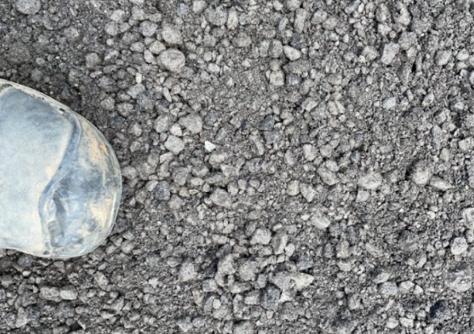 |
Characterizing and Improving Binder Availability and Activity in Asphalt Mixtures with Reclaimed Asphalt PavementVirginia Department of Transportation, PI: Cassie Castorena (NCSU) Abstract: The majority of asphalt mixtures produced in Virginia contain reclaimed asphalt pavement (RAP) due to the associated environmental and economic benefits. In addition, there is growing interest to further increase the amounts of RAP, which poses challenges with respect to mixture durability. The Balanced Mix Design (BMD) procedure, adopted by the Virginia Department of Transportation (VDOT) offers some mitigation of the challenges attributed to mixtures with relatively significant RAP content; however, this strategy is not foolproof. Building off of previous research at NCSU and VTRC, this research will explore the recycled binder availability, activity, and contribution of RAP stockpiles in Virginia in order to encompass mixtures that do not currently have BMD framework and to determine whether volumetrics and/or BMD tests are doing a sufficient job of effectively identifying and mitigating issues with RAP materials that have low binder contribution. The research effort will validate the two performance-based engineered framework developed and recommended as part of Project 177566, characterize the binder availability in typical RAP material stockpiles in Virginia, and develop guidelines or guidance documentation for how RAP availability and activity levels should be accounted for in mix design methods for Virginia, specifically those used to design asphalt mixtures with RAs. |
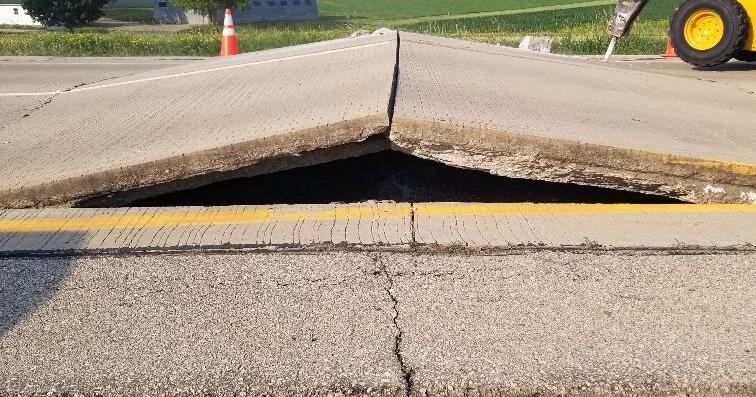 |
Proactive Prevention of Pavement BucklingWisconsin Highway Research Program, PI: Jaime Hernandez (Marquette University) Abstract: Pavement buckling occurs when a rigid or composite pavement surface moves upward at transverse joints or cracks and it occurs, in part, because of excessive compressive forces generated at the joints of the pavement. As temperature increases, concrete slabs expands and compressive forces develop if the joint spacing is insufficient to accommodate this expansion. Buckling is a failure that is becoming more frequent in the U.S. and is usually linked to temperatures higher than historical values. Wisconsin, in particular, has experienced a steady increment in the number of buckling events over the last decade reaching close to 200 in 2021. In this project, a mechanistic model will be created to predict buckling real-life conditions. The mechanistic model will be verified using other approaches and validated with experimental measurements and will capture the effect of the variables identified in previous WHRP studies. Ultimately, the mechanistic model will be used to: assess the vulnerability of Wisconsin’s road network to heatwaves; enhance the understanding of the effects of buckling; recommend approaches to diminish the risk of buckling failure; and create a verification tool that can be merged with Wisconsin’s design, maintenance, and asset management practices. |
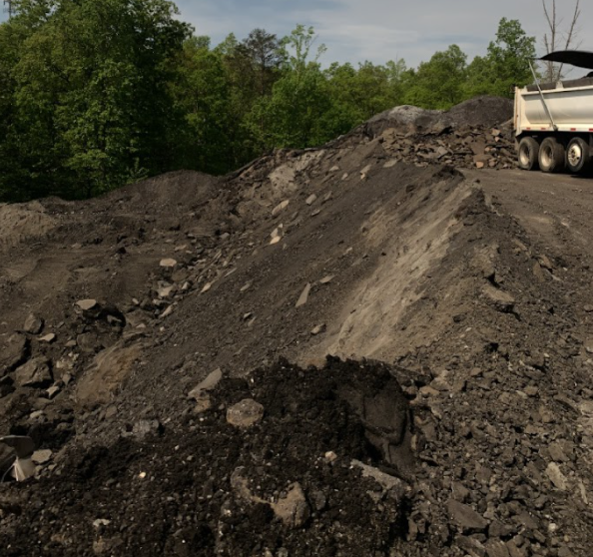 |
Evaluation of RAP/RAS Stockpiles in North Carolina and Changes in these Stockpiles Over TimeNorth Carolina Department of Transportation, PI: Cassie Castorena (NCSU) Abstract: Past and on-going NCDOT research projects have demonstrated substantial variability in the agglomeration, recycled binder availability, and recovered binder properties of reclaimed asphalt pavement (RAP) and recycled asphalt shingle (RAS) materials within North Carolina. These recycled material characteristics are not captured in current quality assurance and control measures. Furthermore, a recent operational review of asphalt plants in North Carolina indicates that unprocessed and processed recycled material stockpiling, crushing operations, and crushing frequency vary. This project will: (1) identify how recycled material stockpiling and processing practices affect the consistency of RAP and RAS properties within stockpiles and among plants, (2) evaluate the impacts of recycled material variability on asphalt mixture performance, and (3) propose modifications to the NCDOT’s current specifications to improve the consistency within and across RAP and RAS stockpiles within North Carolina. |
